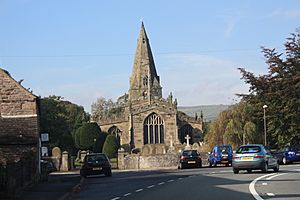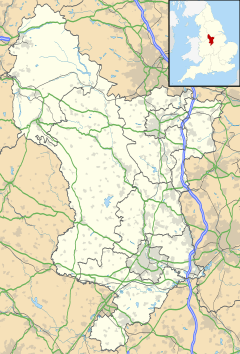Hope, Derbyshire facts for kids
Quick facts for kids Hope |
|
|---|---|
 Parish church of St Peter |
|
| Population | 864 (2011) |
| District |
|
| Shire county | |
| Region | |
| Country | England |
| Sovereign state | United Kingdom |
| Post town | HOPE VALLEY |
| Postcode district | S33 |
| Dialling code | 01433 |
| Police | Derbyshire |
| Fire | Derbyshire |
| Ambulance | East Midlands |
| EU Parliament | East Midlands |
| UK Parliament |
|
Hope is a small village in the beautiful Peak District, England. In 2011, about 864 people lived there.
It is located in the Hope Valley. Here, two rivers, Peakshole Water and River Noe, meet. To the north, you can see two famous hills: Win Hill and Lose Hill.
Contents
History of Hope
Ancient Times
People have lived around Hope for a very long time. Tools from the Mesolithic period (Middle Stone Age) have been found near Win Hill. A stone axe from the Neolithic period (New Stone Age) was also discovered.
The village is close to Mam Tor, an ancient hillfort. Remains of people and pots from the Bronze Age have been found near Lose Hill. There is also a Bronze Age burial mound, called The Folly, which is about 23 meters wide.
Roman Period
You can still find traces of a Roman road called Batham Gate near Hope. There was also a Roman fort called Navio nearby. Many items from this fort are now kept in the Buxton Museum.
Saxon Period
The name Hope comes from an old Anglo-Saxon word. It means a small, enclosed valley. The village name was first written down in 926 AD. It also appeared in the Domesday Book in 1086 AD.
The Roman fort Navio later got an Old English name, brough, meaning fort. This name is now used for the nearby area of Brough and Shatton.
Medieval Period
The Hope Motte is an old earth mound near the Peakshole Water. People think it was built during the Norman times.
The Domesday Book mentions that Hope had a church. The current parish church, St Peter's, was built in the 14th and 15th centuries. It was changed a bit in 1882.
The churchyard has two old crosses. One is a tall sandstone cross from the Anglo-Saxon period. It is seven feet high and has carvings on all sides. Another cross, the Eccles Cross, is also in the churchyard.
Later History
In 1715, Hope started having a weekly market. It also held four yearly fairs, including a "hiring fair" where people could find work.
During the Industrial Revolution, lead mining was important in Pindale. Between 1800 and 1802, the Pindale mine produced a lot of lead. You can still see the old pumping engine house from the mine.
Tin Town
Between 1902 and 1916, a special "Tin Town" was built at Birchinlee. This was for the workers and their families who were building the Derwent and Howden Dams. One of these old buildings was saved and moved to Hope. It is now a beauty salon.
World War II
On October 5, 1943, an RAF bomber crashed near Hope. The plane, a Handley Page Halifax Mark II, was returning from a mission over Germany. One of its engines was damaged by an enemy plane. Five of the seven crew members sadly died.
Economy
Hope is home to the Hope Cement Works. This factory gets its materials from a nearby quarry in Bradwell. The local volunteer mountain rescue team, Edale Mountain Rescue, is based at the cement works.
Culture
The village is known for its traditional well dressing. This is where people decorate local water wells with beautiful pictures made from flower petals and other natural materials.
Transport
Hope railway station is on the Hope Valley line. This line connects Sheffield and Manchester Piccadilly. Trains usually run every hour in both directions.
A main road, the old A625, used to go through the village. However, part of this road near Mam Tor was closed in 1979 because of many landslides. The road is now called the A6187.
Sport
Hope Sports Club was started in 1944. It provides sports facilities for Hope and nearby villages like Aston and Brough.
The village also has its own rugby team, Hope Valley RUFC. They play their home games at Hope Sports Club. The team was formed in 1979 and has had success in local leagues and cup competitions.
Education
Hope Primary School was built in 1912. It serves the children of the village. The building is considered important for its design. Hope also has a small secondary school called Hope Valley College.
See also
 In Spanish: Hope (Derbyshire) para niños
In Spanish: Hope (Derbyshire) para niños



